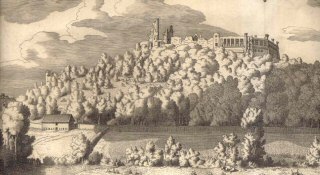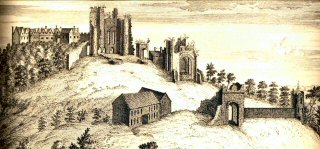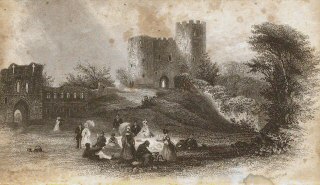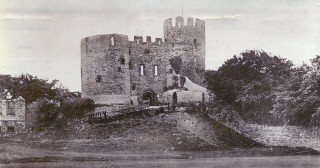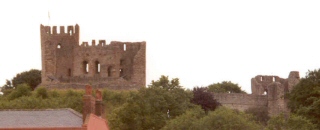The castle is named
after the
nearby town – no reference to Sedgley or Woodsetton! However,
the maps of Christopher Saxton drawn in 1579 and John
Speed, 1610, mark Dudley Castle in the County of Staffordshire not
Worcestershire
thereby linking it to the Manor. This
helps to establish a local claim to one of the oldest buildings in the
Black
Country.
The significance of the castle comes from its development and construction. Set on a limestone ridge, with an ample supply of water, the site was an obvious choice as a save haven for the Saxon community led by Dud, [name variations include Duddah, Dodo and Dudda], around 700AD. By the 1200s walls and dwellings made from stone had replaced simple wooden structures of 1071 – the motte, [wooden tower on earthen mound], and bailey layout was taking on a more solid shape. The keep was added around 1300 and by the middle of the C16th there had been much rebuilding of the fortifications with local limestone and sandstones - some work even showed Italian influences.
The castle lacks events
of major national
importance – a passing visit by the forty two years old Queen
Elizabeth
in 1575 during one of her 'royal progresses', rejection as a possible
place of imprisonment for Mary Queen of Scots in 1585, two minor
English Civil War sieges in 1644 & 1646 and the Great Fire of July
1750 that destroyed the main living quarters hardly rate a mention in
the history books.
In the Victorian age it
was
treated as a ‘romantic ruin’ with many prints selling an
image of
relaxation
against a stylised castle background. The Earls of Dudley allowed
public access and the grounds were used for parades, fairs, balloon
ascents etc.
The last reincarnation
was in
1937 as the centrepiece of the new Zoological Gardens. In this setting the castle reached an
international audience. Currently [2004] there are plans to redevelop
the hill and market the castle and zoo as separate tourist attractions.
The castle is a Scheduled Ancient Monument and some of the zoo
buildings are Grade II listed.
In 1985 the castle hit the headlines with the discovery of the world's oldest surviving condoms found at the bottom of a medieval toilet. They were thought to have been made from the intestines of sheep or pigs and dated at around 1640.
Further information on the history of Dudley Castle can be found on
the Friends of Dudley
Castle, Dudley
Mall, and Sedgley
Manor websites, and while the BBC have a panoramic
view of the current ruins, the dedicated web surfer can also take a
'virtual tour'
of a reconstruction of the Castle. For those of a more classical nature
the most internationally famous representation of Dudley can be found
on the Revolutionary
Players website.
Castle views -
1. Detail of 1686 print
of the ‘east
south east prospect’, the earliest known print of the castle. Source – a page from Dr Robert
Plot’s book,
‘The Natural History of Staffordshire'.
2. Detail of 1731 print
of the ‘south
view’, a popular illustration. Source
–
an original print by Samuel & Nathaniel Buck.
3. August 1841 print of
the
north side of the Keep. Source – page
from William Harris’s book, ‘Rambles about Dudley
Castle’.
4. Detail of 1920s
photograph of the
north side of the Keep. Source - John
Price & Sons postcard.
5. July 2003 photograph
of
the south side of the Keep taken from the town's bus station.
